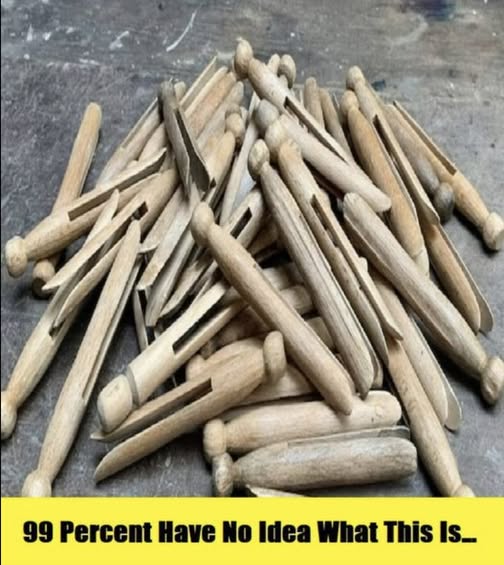Long before washers and dryers became household staples and single socks mysteriously disappeared in high-speed spin cycles, people relied on simpler, more durable tools to get their chores done. One of the most iconic among these tools is the humble wooden clothespin. Though it may seem like a relic from a bygone era, this small device once played a critical role in every home’s laundry routine. Designed with practicality and simplicity in mind, the wooden clothespin evolved from a basic peg to a two-piece tool capable of gripping wet clothes tightly to a line, preventing them from being carried away by the wind—a frustration once described as “a serious evil to washerwomen.”

A recent post on social media shed light on this nostalgic item. A user came across small wooden dowels with two legs and turned to the internet for help identifying them. The post quickly gathered responses, especially from older generations who recognized the objects instantly. “Old school clothespins,” one person replied. “We used them to hang clean, wet clothes outside so they could dry in the sun and fresh air!” This sparked a wave of warm memories from people who grew up before clothes dryers were common and when laundry day meant sunshine, fresh breezes, and lines of fluttering fabric.
The classic wooden clothespin, often called a clothes peg, is a tool designed for holding wet laundry on a clothesline until it dries. The modern version typically consists of two wooden pieces joined at one end with a small metal spring. When you press the ends together, the spring opens the opposite end, allowing the clothespin to grip tightly onto fabric and line alike. This design might seem obvious today, but it represents centuries of trial, error, and innovation.
Clothespins have a surprisingly long history. Before springs and two-piece mechanisms, people made do with simple wooden pegs or carved sticks. Some of the earliest versions were handmade from bone, wood, or even stone. They were often intricately carved, featuring decorative patterns that reflected the artistry and resourcefulness of their makers. Despite their rudimentary appearance, they served the same basic purpose: securing clothes while they dried in the open air.
The clothespin we know today didn’t appear until the 19th century. With industrialization came an increased demand for efficiency in the home. Laundry needed to be done more quickly and dried more securely. Enter David M. Smith of Vermont, who patented a new version of the clothespin on October 25, 1853. Smith’s design introduced the metal spring that allowed the two wooden arms to clamp and release more effectively. According to his patent, the two longer legs of the clothespin could be squeezed together, causing the shorter ends to open and grip the fabric securely. This small but powerful update transformed the clothespin into the practical and durable item that would become a staple in homes for generations.
Smith’s invention made it easier for people—especially the women who typically handled household laundry—to manage the heavy loads of wet clothing. His spring-loaded model not only held garments tighter but also made it easier to attach and remove them from the line. Over time, this design was refined, mass-produced, and eventually became so ubiquitous that we now barely give it a second thought.
Though the popularity of clothespins declined with the rise of electric dryers, they never entirely disappeared. Many people still use them today, not just for drying clothes but for a variety of creative and practical purposes. From chip bag clips to craft projects to makeshift bookmarks, clothespins continue to prove their usefulness in unexpected ways.
The wooden clothespin is more than just a tool—it’s a symbol of resourcefulness, simplicity, and a connection to the past. At a time when many household items are disposable or digitally controlled, the clothespin reminds us of an era when durable, well-designed tools were made to last and serve many roles. Whether hanging sheets out to dry under the sun or sparking nostalgic memories on social media, the wooden clothespin remains a quiet yet enduring piece of everyday history.





